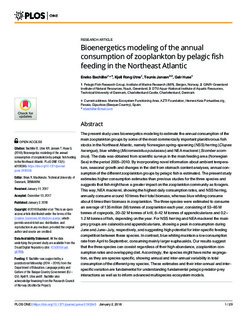Bioenergetics modeling of the annual consumption of zooplankton by pelagic fish feeding in the Northeast Atlantic
Journal article, Peer reviewed
Published version
Permanent lenke
http://hdl.handle.net/11250/2563704Utgivelsesdato
2018Metadata
Vis full innførselSamlinger
- Articles [3009]
- Publikasjoner fra CRIStin [3056]
Originalversjon
10.1371/journal.pone.0190345Sammendrag
The present study uses bioenergetics modeling to estimate the annual consumption of the main zooplankton groups by some of the most commercially important planktivorous fish stocks in the Northeast Atlantic, namely Norwegian spring-spawning (NSS) herring (Clupea harengus), blue whiting (Micromesistius poutassou) and NEA mackerel (Scomber scombrus). The data was obtained from scientific surveys in the main feeding area (Norwegian Sea) in the period 2005–2010. By incorporating novel information about ambient temperature, seasonal growth and changes in the diet from stomach content analyses, annual consumption of the different zooplankton groups by pelagic fish is estimated. The present study estimates higher consumption estimates than previous studies for the three species and suggests that fish might have a greater impact on the zooplankton community as foragers. This way, NEA mackerel, showing the highest daily consumption rates, and NSS herring, annually consume around 10 times their total biomass, whereas blue whiting consume about 6 times their biomass in zooplankton. The three species were estimated to consume an average of 135 million (M) tonnes of zooplankton each year, consisting of 53–85 M tonnes of copepods, 20–32 M tonnes of krill, 8–42 M tonnes of appendicularians and 0.2–1.2 M tonnes of fish, depending on the year. For NSS herring and NEA mackerel the main prey groups are calanoids and appendicularians, showing a peak in consumption during June and June–July, respectively, and suggesting high potential for inter-specific feeding competition between these species. In contrast, blue whiting maintain a low consumption rate from April to September, consuming mainly larger euphausiids. Our results suggest that the three species can coexist regardless of their high abundance, zooplankton consumption rates and overlapping diet. Accordingly, the species might have niche segregation, as they are species specific, showing annual and inter-annual variability in total consumption of the different prey species. These estimates and their inter-annual and inter-specific variation are fundamental for understanding fundamental pelagic predator-prey interactions as well as to inform advanced multispecies ecosystem models.
